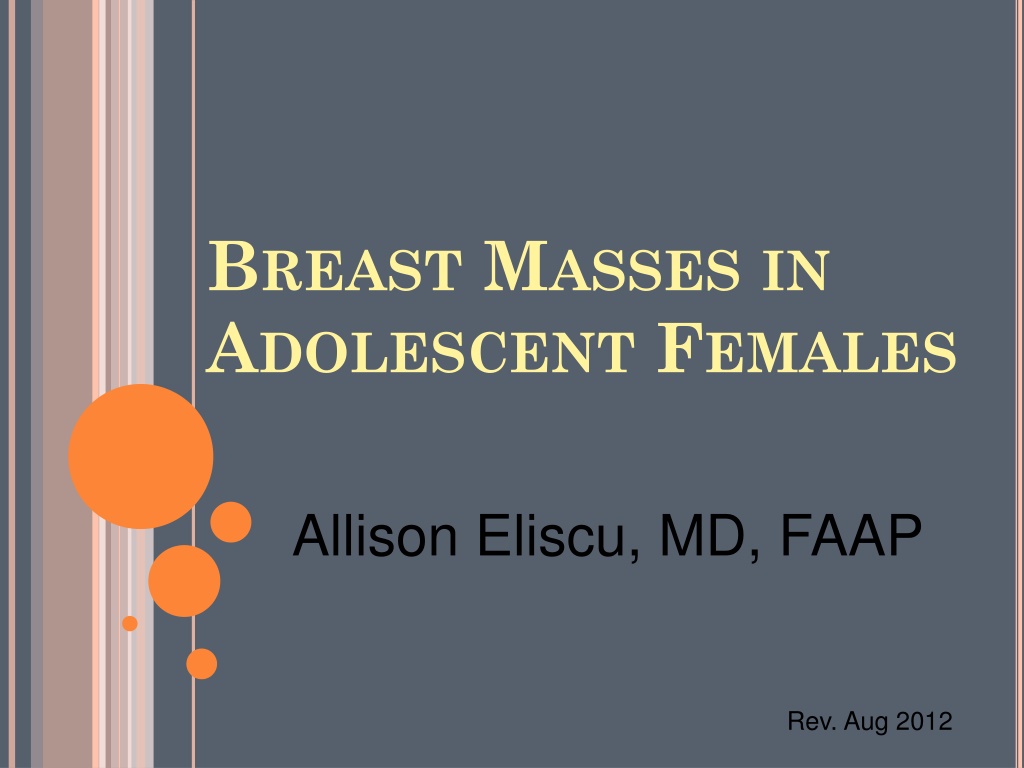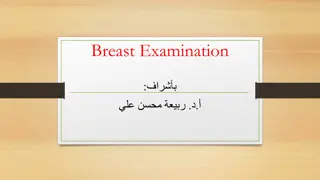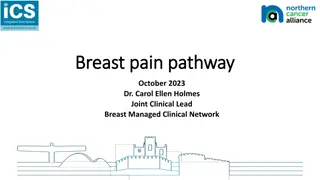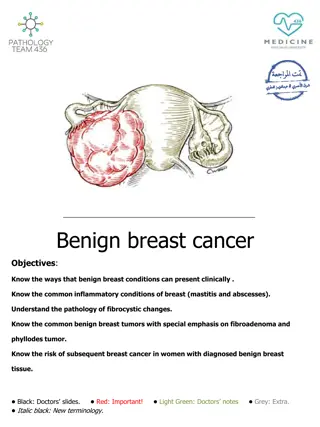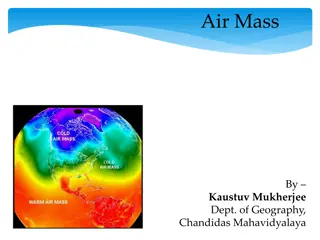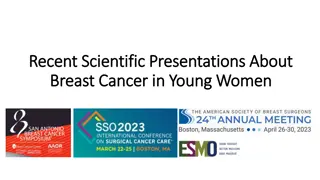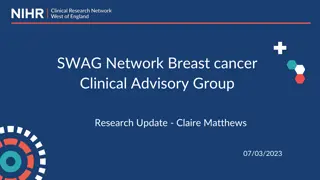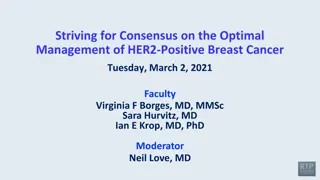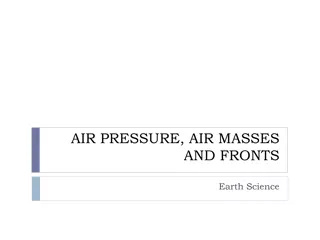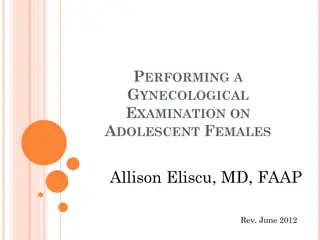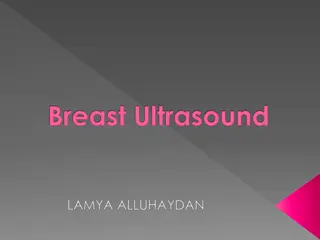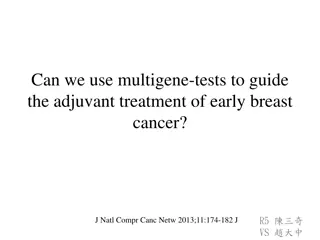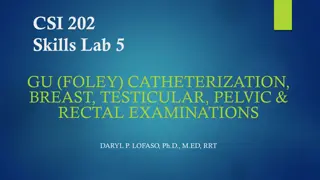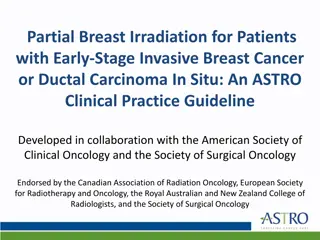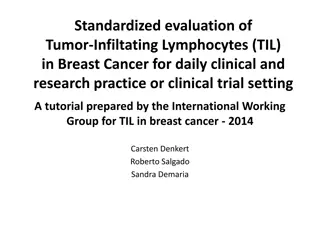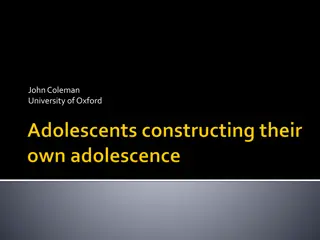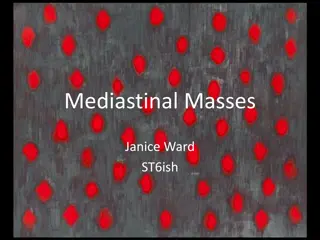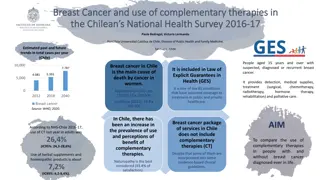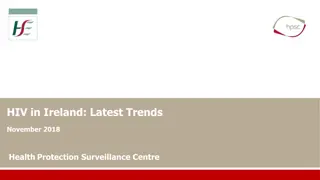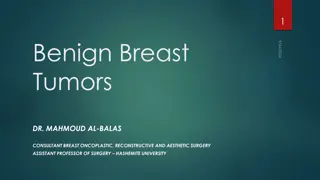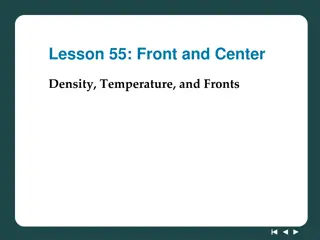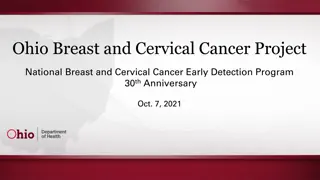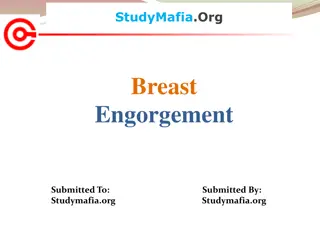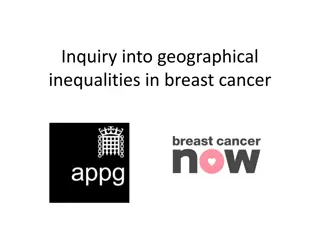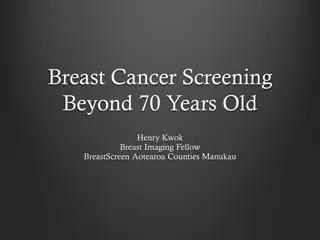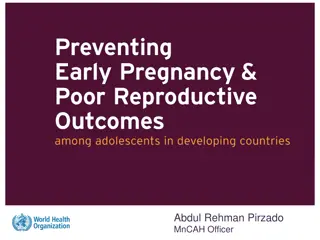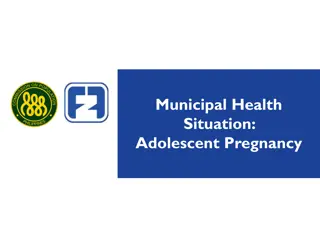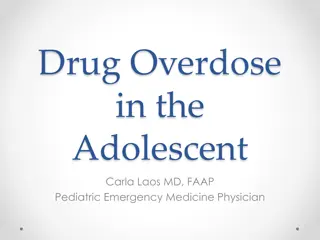Breast Masses in Adolescent Females: Diagnosis and Management
This informative content discusses breast masses in adolescent females, covering crucial aspects such as history, physical examination, and the common causes of breast masses. It elaborates on the differential diagnosis including fibroadenoma, fibrocystic change, mastitis, and rare causes. Detailed information on fibroadenoma, the most common breast mass in adolescent females, along with its management is provided. The content also touches upon fibrocystic changes, their prevalence, and physical exam findings.
Download Presentation

Please find below an Image/Link to download the presentation.
The content on the website is provided AS IS for your information and personal use only. It may not be sold, licensed, or shared on other websites without obtaining consent from the author. Download presentation by click this link. If you encounter any issues during the download, it is possible that the publisher has removed the file from their server.
E N D
Presentation Transcript
BREAST MASSES IN ADOLESCENT FEMALES Allison Eliscu, MD, FAAP Rev. Aug 2012
BREAST MASSES - HISTORY Duration of mass Presence of nipple discharge History of prior breast disease History of prior malignancy or radiation therapy Menstrual history Obstetric history Current medications Family history of malignancy
BREAST MASSES PHYSICAL EXAMINATION Location of mass Consistency (cystic vs. solid) Size Mobility of mass relative to overlying skin Tenderness with palpation Overlying skin changes Attempt to express nipple discharge Check for axillary and supraclavicular lymphadenopathy
DIFFERENTIAL DIAGNOSIS Common Causes Fibroadenoma 67% of adolescent masses Fibrocystic change 15% of adolescent masses Mastitis or abscess 3% of adolescent masses Rare Causes Phylloides tumor Mammary duct ectasia Fat necrosis due to trauma Direct blow or seat belt injury Primary carcinoma of breast Metastatic cancer Extremely rare in adolescents
FIBROADENOMA Most common breast mass in adolescent females Benign mass More common in late adolescents Rapid initial growth size may double in 6-12 months Asymptomatic but may have premenstrual discomfort Physical Exam Findings Well circumscribed Rubbery Mobile Average size 2-3 cm Most commonly in upper outer quadrant Nontender No lymphadenopathy
MANAGEMENTOF FIBROADENOMA Diagnosis based on physical exam findings May confirm with ultrasound Initial management is observation May decrease in size or self-resolve with time NSAIDS for pain Excisional biopsy recommended if: Size >5 cm Growth after initial period of stability Lesion persists to adulthood Incredibly low risk of malignancy Fibroadenoma on ultrasound Note the smooth, well circumscribed lesion
FIBROCYSTIC CHANGE Present in more than 50% of women s breasts Results from estrogen and progesterone imbalance May have premenstrual enlargement and tenderness Physical Exam Findings Cord-like thickening and lumps Exam changes with menstrual cycle May confirm with ultrasound Management NSAIDs for pain Oral contraceptives improve symptoms in 70-90% of cases Decrease caffeine intake
PHYLLODES TUMOR Stromal tumor May be benign, intermediate, or malignant More common in adult women Usually asymptomatic Physical Exam Findings Large, rapidly growing mass Shiny overlying skin due to rapid stretching Bloody discharge may be present if nipple involved Confirm with ultrasound Requires resection
MAMMARY DUCT ECTASIA Blockage of subareolar ducts Presents with sticky, multicolored nipple discharge May lead to infection Confirm with ultrasound Usually self-limited Resection for persistent lesions
BREAST CANCER IN ADOLESCENTS Extremely uncommon during adolescence Suspicious Clinical Findings Hard, irregular shaped mass Mass fixed to chest wall Skin or nipple retraction Nipple discharge Axillary or supraclavicular lymphadenopathy Risk Factors Family history of breast cancer Prior radiation therapy to chest NO ASSOCIATION between oral contraceptive use and risk of breast cancer
BREAST MASSES - SUMMARY Majority of masses in adolescents are benign Many masses are self-limited Ultrasound is preferred imaging modality Mammogram NOT recommended in adolescents Difficult to interpret due to increased breast density Management for most masses is observation only Consider further management for: Large lesions Growing lesions Symptomatic lesions Suspicious lesions
On routine examination of a healthy 17 year old female, you note a small, rubbery, mobile mass in the upper, outer quadrant of the left breast. It is nontender and there is no surrounding lymphadenopathy. The right breast is normal. The most likely diagnosis is A. Gynecomastia B. Fibrocystic change C. Phyllodes tumor D. Fibroadenoma E. Primary breast cancer F. Metastatic cancer to breast
On routine examination of a healthy 17 year old female, you note a small, rubbery, mobile mass in the upper, outer quadrant of the left breast. It is nontender and there is no surrounding lymphadenopathy. The right breast is normal. The most likely diagnosis is A. Gynecomastia B. Fibrocystic change C. Phyllodes tumor D. Fibroadenoma E. Primary breast cancer F. Metastatic cancer to breast
Answer: D. Fibroadenomas are the most common breast masses in adolescent females. They tend to present as asymptomatic, single, rubbery, mobile masses with an average size of 2-3 cm. Diagnosis of a fibroadenoma is usually based on clinical features of the exam. Gynecomastia refers to benign proliferation of breast tissue in a male. Fibrocystic change is also a common entity in adolescent females. Patients with fibrocystic change tend to be asymptomatic but may complain of mild premenstrual discomfort. On examination fibrocystic change is described as cord-like thickening or lumps which change with the menstrual cycle. Phyllodes tumors is less common in adolescent females and tends to be a rapid growing mass which may involve the nipple causing bloody nipple discharge. Breast cancer, both primary and metastatic, is rare in otherwise healthy adolescent females.
An 18 year old otherwise healthy female presents to the office after noticing a lump in her right breast. She started having some discomfort in the area of the lump 2 days ago which made it come to her attention. She denies nipple discharge or medication use and just started her menses this morning. On examination, you find diffuse thickened cord-like areas with a few lumps in both breasts which are mildly tender to palpation. There are no skin changes and no lymphadenopathy. Which of the following is true? A. She most likely has a fibroadenoma and should receive a mammogram B. She most likely has a fibroadenoma and should receive an ultrasound C. She most likely has fibrocystic change and should receive a mammogram D. She most likely has fibrocystic change and should have a repeat examination in a different part of her menstrual cycle E. She most likely has breast cancer and should receive an ultrasound
An 18 year old otherwise healthy female presents to the office after noticing a lump in her right breast. She started having some discomfort in the area of the lump 2 days ago which made it come to her attention. She denies nipple discharge or medication use and just started her menses this morning. On examination, you find diffuse thickened cord-like areas with a few lumps in both breasts which are mildly tender to palpation. There are no skin changes and no lymphadenopathy. Which of the following is true? A. She most likely has a fibroadenoma and should receive a mammogram B. She most likely has a fibroadenoma and should receive an ultrasound C. She most likely has fibrocystic change and should receive a mammogram D. She most likely has fibrocystic change and should have a repeat examination in a different part of her menstrual cycle E. She most likely has breast cancer and should receive an ultrasound
Answer: D. Patients with fibrocystic change are frequently asymptomatic or may have mild premenstrual discomfort. On examination, lesions of fibrocystic change are described as thickened cord-like areas and lumps which may be mildly tender on palpation. Skin changes (ie, stretching or dimpling of the skin) and swollen lymph nodes, which are more common in cancerous lesions, are not typically seen with fibrocystic change. Lesions of fibrocystic change tend to fluctuate with the menstrual cycle so patients with suspected lesions should be examined again during a different part of their menstrual cycle. A fibroadenoma usually presents as a single, rubbery, mobile, asymptomatic mass. Adolescent patients with a breast masses requiring further delineation should receive an ultrasound. Mammograms are more difficult to read in adolescents due to the increased density of the breast tissue and should be avoided in adolescent patients.
RECOMMENDED READING Breast concerns in the adolescent. ACOG Committee Opinion No. 350. American College of Obstetricians and Gynecologists. Obstet Gynecol 2006;108:1329 36. De Silva NK, Brandt ML. Disorders of the Breast in Children and Adolescents. Part 2: Breast masses. J Pediatr Adolesc Gynecol. 2006 Dec;19(6):415-8. Banikarim C, De Silva NK. Overview of Breast Masses in Children and Adolescents. UpToDate Online. Updated February 9, 2009.
